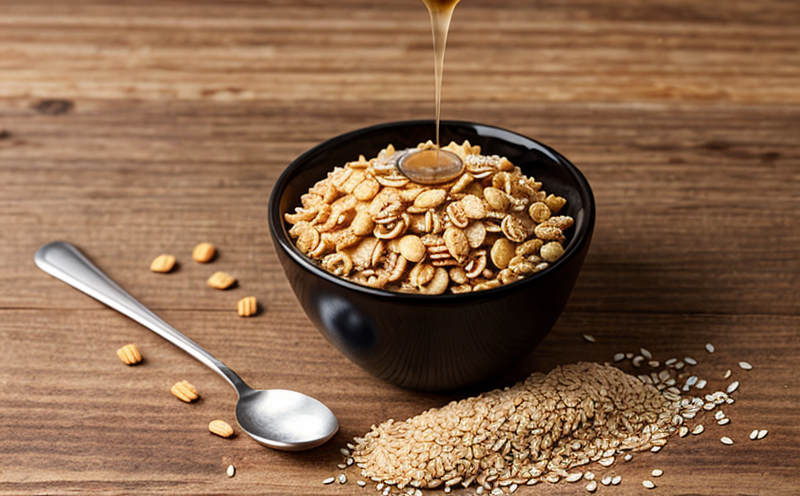Total Viable Count Plate Count Test
The Total Viable Count (TVC) Plate Count Test is a fundamental microbiological assay used to estimate the total number of viable microorganisms in a given sample. This test is crucial for ensuring food safety and quality, especially in sectors like cereal and grain testing where contamination can lead to spoilage or health hazards.
During this procedure, serial dilutions are prepared from the original sample. A known volume of the diluted sample is then inoculated onto agar plates that support microbial growth. Incubation allows for colonies to form on the agar surface. After incubation, the number of colonies is counted and used to calculate the total viable count per gram or milliliter of the initial sample.
The TVC Plate Count Test follows international standards such as ISO 6803:1997 and ASTM E2149-05. These standards provide precise protocols for preparing samples, inoculating agar plates, incubation conditions, and colony counting to ensure accuracy and consistency across laboratories.
For cereal and grain testing, the TVC Plate Count Test is particularly important because grains can harbor various microorganisms that may affect product quality and safety. Contamination by pathogens like Salmonella or Listeria can lead to serious health issues if not detected early in the production process. Therefore, this test plays a vital role in monitoring the microbiological quality of cereals and grains.
The results from the TVC Plate Count Test are reported as colony-forming units (CFUs) per gram or milliliter, providing valuable data for quality control and safety assessments. This information helps stakeholders make informed decisions about product safety and potential recalls if contamination is detected. Properly conducted TVC tests ensure that cereals and grains meet the stringent hygiene standards set by regulatory bodies.
Sample preparation involves thorough aseptic techniques to prevent contamination during handling. The sample is typically homogenized, and appropriate dilutions are made using sterile saline or buffered peptone water. This ensures an accurate representation of the microbial content in the original sample without introducing extraneous microorganisms.
The agar plates used for this test must meet specific criteria regarding their composition to support various types of microorganisms effectively. Commonly used agar includes Nutrient Agar (NA), which provides a broad range of nutrients suitable for many bacteria, or specialized media like Tryptic Soy Agar (TSA) designed specifically for cereal and grain testing.
Incubation conditions vary depending on the type of microorganism being tested but generally follow guidelines from relevant standards. For instance, when testing cereals for spoilage organisms, incubation might be at 30°C to 35°C for 48 hours. This ensures that all viable bacteria have had sufficient time to grow into visible colonies.
The accuracy and reliability of the TVC Plate Count Test are paramount in maintaining food safety standards. Misinterpretation or improper execution can lead to false positives or negatives, potentially compromising product quality and consumer health. Rigorous adherence to standardized procedures ensures consistent results across different laboratories.
Why It Matters
The Total Viable Count Plate Count Test is essential for maintaining the safety and quality of cereal and grain products. By accurately quantifying viable microorganisms present in these raw materials, manufacturers can identify potential contamination issues early on in the production process. Early detection allows for corrective actions to be taken promptly, preventing further spread of contaminants.
This test not only helps in ensuring compliance with food safety regulations but also contributes significantly towards enhancing brand reputation and consumer trust. Consumers increasingly demand transparency regarding how their food is produced and handled; reliable testing results contribute positively to this expectation.
Furthermore, the TVC Plate Count Test aids in monitoring trends over time, helping companies understand seasonal variations or geographical differences in microbial contamination levels within cereal and grain supplies. Such insights enable better resource allocation strategies aimed at minimizing risks associated with poor quality raw materials entering the supply chain.
Industry Applications
Monitoring production environments to ensure cleanliness standards are met.
Quality control during processing stages to identify any cross-contamination issues.
Safety assessment of final products before release onto the market.
Research and development activities focused on developing new formulations or improving existing ones while maintaining safety standards.
The TVC Plate Count Test is widely used across various segments within the food industry, including cereal processors, grain suppliers, bakery manufacturers, and snack producers. Each segment utilizes this test to address unique challenges related to ensuring product integrity and consumer health.
Why Choose This Test
Accurate quantification of viable microorganisms present in cereal and grain samples.
Compliance with international standards like ISO 6803:1997 and ASTM E2149-05.
Supports early detection of potential contamination issues, allowing for timely intervention measures.
Provides valuable data aiding decision-making processes related to product safety and quality control.
Facilitates trend analysis over time, helping companies adapt strategies based on changing conditions within the supply chain or market demands.
Ensures consistency in testing methods across different laboratories through adherence to standardized procedures.
The Total Viable Count Plate Count Test is a cornerstone of food safety protocols worldwide. Its ability to accurately measure microbial populations makes it indispensable for maintaining high standards of hygiene and quality assurance throughout the cereal and grain industry.





